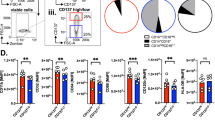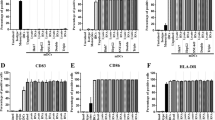Abstract
Antibody-dependent cellular cytotoxicity (ADCC) is one means by which macrophages (as well as natural killer cells and granulocytes) elicit a cytotoxic response. This is achieved via interaction of the Fc-γ-receptor (CD64) with the Fc portion of antibody bound to target cells. We have created a chimeric CD64 molecule that incorporates a single chain Fv molecule, targeted against human carcinoembryonic antigen (CEA), fused to the membrane spanning and cytosolic domains of human CD64. Following adenoviral transfer to primary human monocytes, this chimeric CD64 receptor induced antigen-specific cytokine secretion during culture on immobilised CEA protein or on CEA-expressing tumour cells. Moreover, CEA targeted, but not control, monocytes effectively retarded CEA-positive tumour cell growth in vitro. Importantly, targeted monocyte cultures significantly reduced in vivo tumour growth rates in xenograft studies resulting in improved survival rates over that of control monocyte cultures. These data suggest that genetically directing monocytes against tumour antigens may be a useful means of achieving an immunotherapeutic response.
This is a preview of subscription content, access via your institution
Access options
Subscribe to this journal
Receive 12 print issues and online access
$259.00 per year
only $21.58 per issue
Buy this article
- Purchase on Springer Link
- Instant access to full article PDF
Prices may be subject to local taxes which are calculated during checkout





Similar content being viewed by others
Accession codes
References
Bingle L, Brown NJ, Lewis CE . The role of tumour-associated macrophages in tumour progression: implications for new anticancer therapies. J Pathol 2002; 196: 254–265.
Andreesen R, Scheibenbogen C, Brugger W, Krause S, Meerpohl HG, Leser HG et al. Adoptive transfer of tumor cytotoxic macrophages generated in vitro from circulating blood monocytes: a new approach to cancer immunotherapy. Cancer Res 1990; 50: 7450–7456.
Brugger W, Scheibenbogen C, Krause S, Andreesen R . Large-scale production of human tumorcytotoxic macrophages grown from blood monocytes of cancer patients. Cancer Detect Prev 1991; 15: 407–412.
Eymard JC, Lopez M, Cattan A, Bouche O, Adjizian JC, Bernard J . Phase I/II trial of autologous activated macrophages in advanced colorectal cancer. Eur J Cancer 1996; 32A: 1905–1911.
Hennemann B, Rehm A, Kottke A, Meidenbauer N, Andreesen R . Adoptive immunotherapy with tumor-cytotoxic macrophages derived from recombinant human granulocyte-macrophage colony-stimulating factor (rhuGM-CSF) mobilized peripheral blood monocytes. J Immunother 1997; 20: 365–371.
Andreesen R, Hennemann B, Krause SW . Adoptive immunotherapy of cancer using monocyte-derived macrophages: rationale, current status, and perspectives. J Leukocyte Biol 1998; 64: 419–426.
Hennemann B, Beckmann G, Eichelmann A, Rehm A, Andreesen R . Phase I trial of adoptive immunotherapy of cancer patients using monocyte-derived macrophages activated with interferon gamma and lipopolysaccharide. Cancer Immunol Immunother 1998; 45: 250–256.
Monnet I, Breau JL, Moro D, Lena H, Eymard JC, Menard O et al. Intrapleural infusion of activated macrophages and gamma-interferon in malignant pleural mesothelioma: a phase II study. Chest 2002; 121: 1921–1927.
Herlyn D, Koprowski H . IgG2a monoclonal antibodies inhibit human tumor growth through interaction with effector cells. Proc Natl Acad Sci USA 1982; 79: 4761–4765.
Kawase I, Komuta K, Hara H, Inoue T, Hosoe S, Ikeda T et al. Combined therapy of mice bearing a lymphokine-activated killer-resistant tumor with recombinant interleukin 2 and an antitumor monoclonal antibody capable of inducing antibody-dependent cellular cytotoxicity. Cancer Res 1988; 48: 1173–1179.
Dyall R, Vasovic LV, Clynes RA, Nikolic-Zugic J . Cellular requirements for the monoclonal antibody-mediated eradication of an established solid tumor. Eur J Immunol 1999; 29: 30–37.
Clynes R, Takechi Y, Moroi Y, Houghton A, Ravetch JV . Fc receptors are required in passive and active immunity to melanoma. Proc Natl Acad Sci USA 1998; 95: 652–656.
Ravetch JV, Bolland S . IgG Fc receptors. Annu Rev Immunol 2001; 19: 275–290.
Michon J, Moutel S, Barbet J, Romet-Lemonne JL, Deo YM, Fridman WH et al. In vitro killing of neuroblastoma cells by neutrophils derived from granulocyte colony-stimulating factor-treated cancer patients using an anti-disialoganglioside/anti-Fc gamma RI bispecific antibody. Blood 1995; 86: 1124–1130.
Russoniello C, Somasundaram C, Schlom J, Deo YM, Keler T . Characterization of a novel bispecific antibody that mediates Fcgamma receptor type I-dependent killing of tumor-associated glycoprotein-72-expressing tumor cells. Clin Cancer Res 1998; 4: 2237–2243.
Goldstein J, Graziano RF, Sundarapandiyan K, Somasundaram C, Deo YM . Cytolytic and cytostatic properties of an anti-human Fc gammaRI (CD64) x epidermal growth factor bispecific fusion protein. J Immunol 1997; 158: 872–879.
Chester KA, Begent RH, Robson L, Keep P, Pedley RB, Boden JA et al. Phage libraries for generation of clinically useful antibodies. Lancet 1994; 343: 455–456.
Gilham DE, O'Neil A, Hughes C, Guest RD, Kirillova N, Lehane M et al. Primary polyclonal human T lymphocytes targeted to carcino-embryonic antigens and neural cell adhesion molecule tumor antigens by CD3zeta-based chimeric immune receptors. J Immunother 2002; 25: 139–151.
Gross G, Waks T, Eshhar Z . Expression of immunoglobulin-T-cell receptor chimeric molecules as functional receptors with antibody-type specificity. Proc Natl Acad Sci USA 1989; 86: 10024–10028.
Hwu P, Shafer GE, Treisman J, Schindler DG, Gross G, Cowherd R et al. Lysis of ovarian cancer cells by human lymphocytes redirected with a chimeric gene composed of an antibody variable region and the Fc receptor gamma chain. J Exp Med 1993; 178: 361–366.
Weijtens ME, Willemsen RA, Valerio D, Stam K, Bolhuis RL . Single chain Ig/gamma gene-redirected human T lymphocytes produce cytokines, specifically lyse tumor cells, and recycle lytic capacity. J Immunol 1996; 157: 836–843.
Hombach A, Koch D, Sircar R, Heuser C, Diehl V, Kruis W et al. A chimeric receptor that selectively targets membrane-bound carcinoembryonic antigen (mCEA) in the presence of soluble CEA. Gene Therapy 1999; 6: 300–304.
Eshhar Z, Waks T, Bendavid A, Schindler DG . Functional expression of chimeric receptor genes in human T cells. J Immunol Methods 2001; 248: 67–76.
Maher J, Brentjens RJ, Gunset G, Riviere I, Sadelain M . Human T-lymphocyte cytotoxicity and proliferation directed by a single chimeric TCRzeta/CD28 receptor. Nat Biotechnol 2002; 20: 70–75.
Sheen AJ, Sherlock DJ, Irlam J, Hawkins RE, Gilham DE . T lymphocytes isolated from patients with advanced colorectal cancer are suitable for gene immunotherapy approaches. Br J Cancer 2003; 88: 1119–1127.
Chester KA, Robson L, Keep PA, Pedley RB, Boden JA, Boxer GM et al. Production and tumour-binding characterization of a chimeric anti-CEA Fab expressed in Escherichia coli. Int J Cancer 1994; 57: 67–72.
Begent RH, Verhaar MJ, Chester KA, Casey JL, Green AJ, Napier MP et al. Clinical evidence of efficient tumor targeting based on single-chain Fv antibody selected from a combinatorial library. Nat Med 1996; 2: 979–984.
Haynes NM, Snook MB, Trapani JA, Cerruti L, Jane SM, Smyth MJ et al. Redirecting mouse CTL against colon carcinoma: superior signaling efficacy of single-chain variable domain chimeras containing TCR-zeta vs Fc epsilon RI-gamma. J Immunol 2001; 166: 182–187.
Burke B, Sumner S, Maitland N, Lewis CE . Macrophages in gene therapy: cellular delivery vehicles and in vivo targets. J Leukocyte Biol 2002; 72: 417–428.
Repp R, van Ojik HH, Valerius T, Groenewegen G, Wieland G, Oetzel C et al. Phase I clinical trial of the bispecific antibody MDX-H210 (anti-FcgammaRI x anti-HER-2/neu) in combination with Filgrastim (G-CSF) for treatment of advanced breast cancer. Br J Cancer 2003; 89: 2234–2243.
Guest RD, Hawkins RE, Kirillova N, Cheadle EJ, Arnold J, O'Neill A et al. The role of extracellular spacer regions in the optimal design of chimeric immune receptors: evaluation of four different scFvs and antigens. J Immunother 2005; 28: 203–211.
Hardy S, Kitamura M, Harris-Stansil T, Dai Y, Phipps ML . Construction of adenovirus vectors through Cre-lox recombination. J Virol 1997; 71: 1842–1849.
Lowenstein P, Shering A, Bain D, Castro M, Wilkinson G . The use of adenoviral vectors to transfer genes to identified target brain cells in vitro. In: Lowenstein P, Enquist L (eds). Protocols for Gene Transfer in Neuroscience: Towards Gene Therapy of Neurological Disorders. John Wiley and Sons: Hoboken, NJ, 1996, pp 93–114.
Southgate T, Kingston P, Castro M . Gene transfer into neural cells. In: Sibley D (ed). Current Protocols in Neuroscience. John Wiley and Sons: Hoboken, NJ, 2000, pp 23.21–24.23.40.
Dion LD, Fang J, Garver Jr RI . Supernatant rescue assay vs polymerase chain reaction for detection of wild type adenovirus-contaminating recombinant adenovirus stocks. J Virol Methods 1996; 56: 99–107.
Acknowledgements
We thank Professor Robert Hawkins (Medical Oncology, Paterson Institute for Cancer Research, [PICR]) for advice and support and Lorna B Woolford (Cancer Reseach UK Gene Therapy Unit, PICR) for technical assistance. The PICR molecular biology, FACs and BRU core facilities provided invaluable help. This work was supported by Christie Hospital NHS Endowments (AB) and Cancer Research UK (TS, LF, DG).
Author information
Authors and Affiliations
Corresponding author
Additional information
Supplementary Information accompanies the paper on Gene Therapy website (http://www.nature.com/gt)
Supplementary information
Rights and permissions
About this article
Cite this article
Biglari, A., Southgate, T., Fairbairn, L. et al. Human monocytes expressing a CEA-specific chimeric CD64 receptor specifically target CEA-expressing tumour cells in vitro and in vivo. Gene Ther 13, 602–610 (2006). https://doi.org/10.1038/sj.gt.3302706
Received:
Revised:
Accepted:
Published:
Issue Date:
DOI: https://doi.org/10.1038/sj.gt.3302706
Keywords
This article is cited by
-
Evolution of cell therapy for renal cell carcinoma
Molecular Cancer (2024)
-
Sophisticated genetically engineered macrophages, CAR-Macs, in hitting the bull’s eye for solid cancer immunotherapy approaches
Clinical and Experimental Medicine (2023)
-
Macrophages as tools and targets in cancer therapy
Nature Reviews Drug Discovery (2022)
-
Generation of dendritic cells and macrophages from human induced pluripotent stem cells aiming at cell therapy
Gene Therapy (2011)
-
Targeting of mesenchymal stem cells to ovarian tumors via an artificial receptor
Journal of Ovarian Research (2010)



